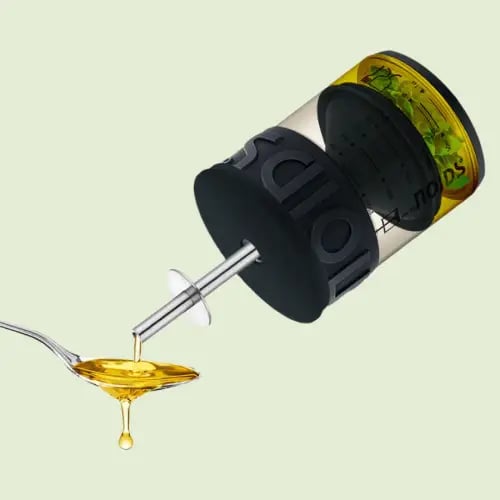I was both excited and anxious when I discovered the idea of infusing cooking oil with cannabis. Because I was new to the world of cannabis and had bought a few grams of raw cannabis from a grow club near me, I knew full well that if I got it wrong I would have wasted that money.
I read everything online that I could easily access and watched no-end of YouTube videos. Many people had backyards filled with cannabis plants, resulting in a large supply. They were not as anxious as me with my few (expensive) grams that I had bought. Little did I know that the process was quite straightforward.
Table of Contents
Why Make Your Own Cannabis Oil?
Have you ever thought about making your own cannabis oil? If not, let’s explore some compelling reasons why it might be worth your while. Here’s why you should consider it:
Cost-effectiveness Compared to Store-bought Versions
First off, let’s talk about money. Store-bought cannabis oil can be pretty expensive. Many brands charge a premium for their products. When you make your own oil, you save those hard-earned dollars. The initial investment in materials may seem daunting, but over time, the savings add up. Think of it this way: why spend $60 when you can make it for $15?
Store-bought products have clear quality and potency, while individuals like me lack access to costly testing equipment. I still think DIY cannabis-infused oil is the way to go because the final testing is me! I decide for myself if that batch was effective for me, worked well, reduced my pain and/or was a lot of fun!
Control Over Potency and Strain Used
Another big advantage is control. Do you prefer a particular strain? Want to adjust the potency to match your needs? Making your own cannabis oil allows you to select the strain for its terpene profile and regulate THC or CBD levels. This means you can tailor the oil to suit your personal preferences perfectly.
Creative Freedom in Flavour Infusions
Do you take pleasure in exploring different flavours? When you make your cannabis oil, you can infuse it with your favourite herbs, spices, or even citrus fruits. Imagine uplifting your oil with a hint of lemon or a splash of peppermint. The options are endless. Break free from common store-bought flavours and get creative in the kitchen with unique recipes.
My two regular combinations are a blend of Mediterranean herbs and a chilli blend. Chilli cannabis oil isn’t just for savoury dishes; it elevates weed chocolate to a whole new level – delicious!

Health Benefits of Homemade Over Commercial Products
Let’s not overlook the health aspect. Typically, infused oils are made with Sunflower oil or Coconut oil. They are both good choices for most people as they have a neutral flavour, but I find that Sunflower oil raises my inflammation levels and this is quite common in Omega-6 seed oils. For that reason, I choose to use Rice Bran oil instead, which is higher in Omega-9.
You may have also wondered what the difference is between Hemp Oil vs CBD Oil.
The Basics of Infusing Oil: What You Need to Know
When it comes to infusing oil, understanding the essentials is paramount. So, let’s dive right in.
Essential Ingredients: Cannabis and a Suitable Oil
The first step is choosing your ingredients. Cannabis is the star of the show, but it needs a buddy which is a suitable oil. So, why is the right oil important? Well, oils carry the cannabinoids and terpenes from the cannabis, allowing you to experience all the benefits.
The oil will need to be heated and so it must be heat stable. Oils like Rosehip, Borage, Chia Seed are not heat-stable. It might surprise you to find that Hemp Seed oil is not heat stable either. It has a great balanced profile of essential fatty acids that make it beneficial for skin, but these EFA’s are easily degraded by the heating process.
Common Types of Carrier Oils and Their Benefits
Let’s explore some popular carrier oils:
- Olive Oil: Great for cooking, it has health benefits and an appealing flavour. It doesn’t need to be the expensive Extra Virgin Olive oil either. You can read a lot more about uses for cannabis-infused Olive oil for Skin and Hair Care.
- Coconut Oil: Solid at room temperature, it’s perfect for baking or making homemade edibles and adds a creaminess to the mouth feel.
- Avocado Oil: Packed with nutrients, it has a high smoke point, making it perfect for heating to infuse cannabis.
- Rice Bran Oil: It has a neutral flavour and a very high smoke point and because it contains Vitamin E and Tocotrienols, it is not damaged by the heat needed to infuse it.
- Sesame Oil: NOT the toasted Sesame oil, but even so, this is not to everyone’s taste as it does have a slight nuttiness to it. I love it to make edibles and find it goes nicely with chocolate edibles, as well as Asian inspired ingedients like star anise.
Each oil brings something unique to the table. So, experiment and find what suits your taste and needs, but always check that the oil is heat stable and don’t forget to decarboxylate your cannabis first.
Understanding Decarboxylation and Why It’s Critical
Now, let’s talk about decarboxylation. It’s a big word, but the concept is simple. Decarboxylation is the process that converts THCA (the non-psychoactive precursor) into THC, which is what gives you that euphoric high.
If you were to eat fresh cannabis flowers, you would get no effect because they contain THCA which does not make you high. The fresh flowers also contain CBDA which has no benefit to you.
We dry the fresh buds for two reasons; to dry them enough that they do not develop mould, and to reduce the strength of the chlorophyll flavour, which is pretty nasty. Even when dried, they do not have the potency we want. They need to be decarbed to convert the THCA into THC cannabinoid and the CBDA into CBD cannabinoid. That’s when the magic starts to happen.
Using the POT by NOIDS Herbal Decarboxylator
For those looking for an easy solution, consider the POT by NOIDS herbal decarboxylator. It simplifies the process by ensuring even heat distribution which protects the precious cannabinoids. Just put your cannabis inside, set the temperature, and let it do its magic. No guesswork needed!
With the PBN you can decarb for THC or CBD and infuse oils and butter for THC or CBD. You can also include any herbs and spices you want when you infuse. You can also make tinctures with it, and it even reclaims the expensive alcohol to use for another time. Evaporate enough alcohol, and you will have FECO (Full Extract Cannabis Oil). You can read my Review of the POT by NOIDS.
As a starting point, add 1g of weed to the glass containers and put the lid on so the house won’t smell of weed. Then set the machine to THC or CBD to decarb. Then add 100g of whichever heat-stable oil you want and set to infuse. Then use the PBN filter to strain it. You can change all these ratios the next time you make a batch, and you can also scale up. This is just a starting point for you to try.

Sure, it’s a considered purchase, but all the machines are and this is the only one that does it all. I have had mine for over 5 years now with no problems at all. Maybe it’s time to treat yourself?
Dosing Cannabis Oil: Finding Your Sweet Spot
Dosing cannabis oil can be a tricky process. If you’re new to this journey, remember to start low and go slow. This fundamental principle is crucial in finding your individual sweet spot. What does that mean, exactly?
Starting Low: The Importance of Gradual Dosing
When trying out your new oil, it’s tempting to dive right in. It can almost feel like you are wasting your weed if you don’t get a full on effect right away, but trust me – don’t do what I did. Right at the start of the Covid breakout, I made a fruit cake loaded with cannabis-infused coconut oil. I just chucked it all in. I licked the spoon and as soon as the cake was made I had a good slice – and ate all the crumbly bits as well.
Three hours later I was on the sofa wishing I had a stop button. It was way too much for me. For a split second I considered getting to a hospital, but I already knew from the news that the hospitals were full to overflowing with Covid patients on trolleys in the corridors!
I put the TV on to nice programmes (nothing gory!), got a bottle of water out and settled down to ride it out. It was not pleasant. So, here are my two biggest tips for you. Before you start, buy a bottle of CBD oil because a few drops or spray under your tongue will take the edge off the rush. Secondly, don’t be a twat in the first place – start low and go slow. You’re welcome 🙂
Starting with a low dose helps us gauge our body’s reaction. Each of us has a unique tolerance level. Gradual dosing allows you to observe changes in your body without feeling overwhelmed. By beginning with small amounts, we minimise the risk of experiencing overwhelming effects. Aim for small increases, and always give your body time to respond.
Factors Influencing Individual Tolerances
Speaking of unique tolerances, there are several factors at play:
- Body weight: Heavier individuals may require more cannabis to feel effects.
- Consumption Method: Medical cannabis drops under the tongue will kick in very fast.
- Metabolism: A faster metabolism might mean quicker effects.
- Experience: Veterans can often tolerate higher doses than newcomers.
- Current medications: Some medications can interact with cannabis.
Recognising your individual factors can help you find that sweet spot more effectively.
Estimating THC Content in Your Homemade Oil
Creating your own cannabis oil is so rewarding. But how do you know how much THC is in your concoction? It is essential to understand certain things.
- Make a note of the weight of cannabis used.
- Determine the THC percentage of the strain (check online). Different strains will vary a lot.
- Relax – the lovely people who make the POT by NOIDS have a free calculator.
Creative Ways to Use Your Cannabis Oil
You can use this oil to make a cannabis-infused balm which you can tweak for many different uses.
Have you ever wondered how to elevate your meals with cannabis oil? Well, here’s some creative and fun ideas for you! Using cannabis oil is more than just taking a few drops. It can really transform your culinary creations into something special. Let’s dive into some tasty options.
Make it into Gummies
You need a cannabis-infused oil to make gummies and coconut is a good oil for this. Here’s a free recipe for How to Make Easy Vegan Cannabis Gummies.
Incorporating It Into Baked Goods
Create edibles. Baking with cannabis oil can be an absolute game changer. Imagine biting into a warm, rich brownie enriched with the soothing effects of cannabis. It’s as delightful as it sounds! The trick is understanding how to measure the potency properly. Too much can overpower the flavour, while too little may not offer the benefits you’re after. Here’s my Fool-Proof Recipe. Remember to keep your edibles away from children and pets.
A Healthy Kick in Salads and Dressings
Want to take your salad to the next level? Adding culinary cannabis oil to your dressings gives a healthy kick and adds depth. It’s a great way to integrate cannabis into a fresh and nutritious meal. Just imagine drizzling a citrus vinaigrette over greens, topped with seeds and nuts, all infused with cannabis oil!
Here’s a quick dressing recipe:
- 3 tablespoons cannabis-infused olive oil
- 1 tablespoon lemon juice
- Salt and pepper to taste
Shake it up and drizzle it over your favourite salad!

Using It As a Finishing Oil
Using cannabis oil as a finishing oil can truly enhance the flavour of your dishes. Drizzle it over cooked veggies, pasta, or grilled meats just before serving. It adds a luscious texture and depth of flavour that’s just unrivalled. Plus, it’s an easy way to introduce the potency of cannabis micro dosage without changing the whole dish.
Creative Pairings with Condiments
Why not get adventurous? Pairing cannabis oil with condiments can yield mouth-watering combinations. Consider mixing it with:
- Mustard for a zesty kick in sandwiches.
- Hot sauce for an exciting heat level.
- Honey can create a sweet and savoury glaze.
The possibilities are endless—just let your imagination run wild!
These creative uses not only add flavour but can also enhance the overall experience of your meal. So, why not give these methods a try in your kitchen next time? You might just find your new favourite way to enjoy cannabis oil!
You might like to read my blog 5 Easy Beginners Cannabis Recipes.
Storing and Preserving Your Homemade Cannabis Oil
Once you’ve crafted that perfect batch, how do you keep it in top shape? We all want our homemade oil to last as long as possible, right? Let’s dive into the best storage methods to ensure freshness.
Best Practices for Storage: Cool and Dark Spaces
The first rule of thumb for storing cannabis oil is simple: keep it in a cool, dark place. Heat and light can degrade the quality of your oil over time. A cupboard or pantry away from the stove or direct sunlight is ideal.
How Long Will Your Oil Last?
We’ve all heard about expiration dates, but how long can you really expect your cannabis oil to last? Typically, it should keep for about 6 months to a year if stored properly, especially if your base oil is well within its best before date. An old oil is much more likely to spoil.
But, there are signs of spoilage to watch for. Does it smell off? Has the colour changed? If you notice any of these changes, it’s better to err on the side of caution and toss it out.
Container Recommendations for Maintaining Freshness
Choosing the right container can heavily influence your oil’s longevity. Opt for dark glass or opaque containers. They protect against UV light and help retain potency. Airtight lids? A must! Lastly, avoid plastic containers, as they can leach chemicals into your oil over time.
Tips for Labelling Your Homemade Oils
It’s smart to label your oil clearly. Include the date of production, the strain and amount of weed as well as the oil used. This avoids confusion and helps you track freshness. A simple label can make all the difference. Imagine reaching for oil and being uncertain about its contents — not fun!
FAQ
What is the key to unlocking the magic of homemade canna oil?
The key to making homemade canna oil lies in understanding decarboxylation. This is basically heating your cannabis buds to activate the cannabinoids. Without this step, you won’t fully experience the effects of edibles when you make an oil infusion.
How do I make canna butter, and what’s the difference between that and canna oil?
Making canna butter is super similar to making canna oil. Both require decarboxylated cannabis, but while canna butter uses butter as the fat, canna oil typically uses oils like Olive or Coconut. If you want a versatile product for baking or cooking, canna butter is your go-to, but if you’re looking for something lighter or to use in dressings, then make canna oil. The culinary possibilities are endless!
What are some tips and tricks for beginners in the cannabis world?
For beginners, diving into the cannabis world can feel overwhelming, but it doesn’t have to be! Start with small batches to avoid wasting plant material and always measure your ingredients carefully. When it comes to choosing the right strain for the terpenes and potency, think about the amount of THC you’re comfortable with. Remember that the effects of edibles dosage can vary from person to person, so it’s best to gradually increase as needed.
How do I ensure even distribution of THC in my homemade oil?
To achieve even distribution of THC and all the cannabinoids in your DIY canna oil, make sure you thoroughly mix your decarboxylated cannabis with the oil and heat it gently for the recommended time. The POT by NOIDS does this to perfection without you having to worry about it.
Conclusion
Storing and preserving your homemade cannabis-infused oil is crucial for maintaining its quality. Stick to cool, dark locations, and choose suitable containers to lock in freshness. By being attentive to spoilage signs and labelling properly, you can enjoy your creation longer. So, take these tips to heart, and cheers to your homemade oil staying potent and delightful for months to come!

If you liked this blog post, I would love it if you shared it with a friend.
If you use Pinterest, please pin this post.
*As a POT by NOIDS affiliate, I earn from qualifying purchases.
*As an Amazon Associate, I earn from qualifying purchases.








